The Intel Xeon E3 series is the go-to processor family for many low power applications. It is a single socket architecture with dual channel memory and a maximum of 4 cores and 8 threads. Although based on desktop counterparts, the Intel Xeon E3-1200 series has the benefit of being able to use ECC memory and features such as Vt-d. Intel does not allow ECC memory use with the Core i7 or Core i5 families at present, but it does allow the Core i3 to use ECC memory and function in server platforms. That certainly makes the dual core, 4 thread Core i3 platforms interesting for virtualized firewall and NAS functions among other use cases.
Today we are taking three processors, the Intel Xeon E3-1230 V3, Core i3-4360 and Core i3-4330 processors and running them through our benchmarks. The first bit of information is that there is a significant price delta between each, and Intel is in the middle of releasing the updated Broadwell core i3 chips. We did not have the E3-1231 v3 (100MHz faster) on hand, but wanted to do a quick comparison of the Haswell options. Here is a quick view of the cost differential:
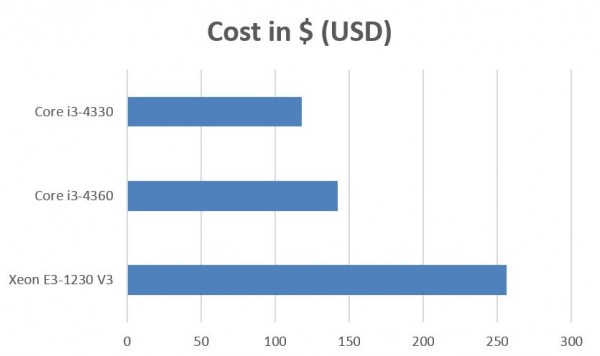
Although it appears as though the Core i3-4330 is half the cost of the Xeon E3-1230 v3, that is a very narrow view. By the time a motherboard, chassis, power supply, RAM and drive(s) are factored in, the differential in system cost is usually only 10-20%.
Test Configuration
For this test configuration, we attempted to utilize a test configuration similar to what we used in the Xeon E3 V3 test beds.
- CPU: Intel Xeon E3-1230 V3, Core i3-4360 and i3-4330
- Motherboard: Supermicro X10SL7-F
- Memory: 16GB Kingston ECC 1600 CL11 DDR3 2x 8GB UDIMMs
- OS Drive: Intel DC S3500 480GB
- Enclosure: Norco RPC-4224
- Power Supply: Corsair AX750 750w 80Plus Gold PSU and PicoPSU 150XT with 150w power brick for power consumption testing.
- OS: Ubuntu Server 14.04 LTS
The nice part about this configuration is that it allows one to use the same motherboard.
c-ray 1.1
c-ray 1.1 benchmarks are a go-to and scalable test that simulates ray tracing. For higher-end dual-socket configurations we typically look at the medium and hard tests however these are lower end platforms where the easy test is still applicable.
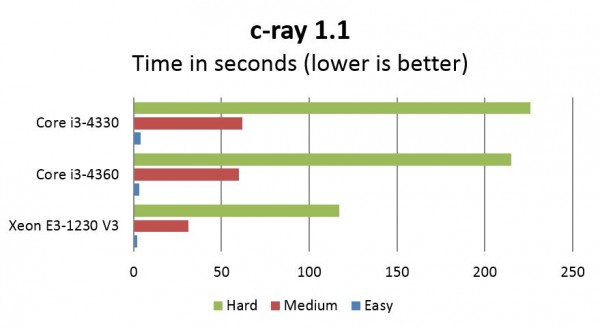
Overall, the multi-threaded test shows a major improvement moving to the 4C/8T Xeon. This is a pattern we expect to see across benchmarks
7-zip Compression
Our 7-zip benchmarks test a common server function: compression.
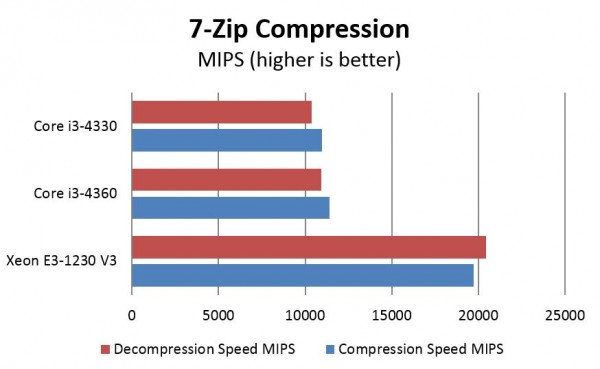
Compression is something that many of these lower-end machines will have to do on a regular basis. Whether for NAS applications or web serving, compression favors multi-threaded architectures.
HardInfo Cryptohash
HardInfo is the “default” Ubuntu benchmark and the cryptohash cryptography tests is a mainstay piece of the benchmark.
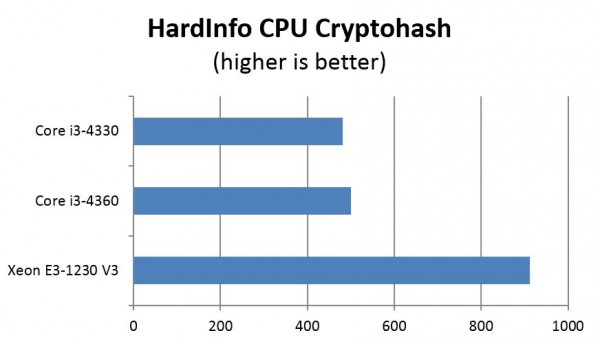
Crypto algorithms are also important for VPN and other applications. The Intel Xeon just about doubles the performance of the Core i3 processors.
Sysbench CPU
Sysbench is an extremely popular Linux benchmark and we are using the CPU test to compare processors.
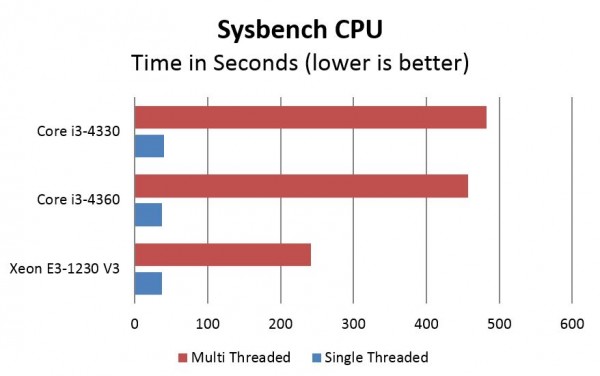
Sysbench single threaded results show the other side to this story. For applications that are not well threaded, the Intel Core i3 performs about on par with the Intel Xeon E3 series.
UnixBench
We look at both UnixBench 5.1.3’s single and multi-threaded dhrystone nad whetstone results (integer and double precision floating point). After doing our normal single threaded and multi-threaded only graphs, we realized the scale was too far off and therefore now have dhrystone and whetstone result sets.
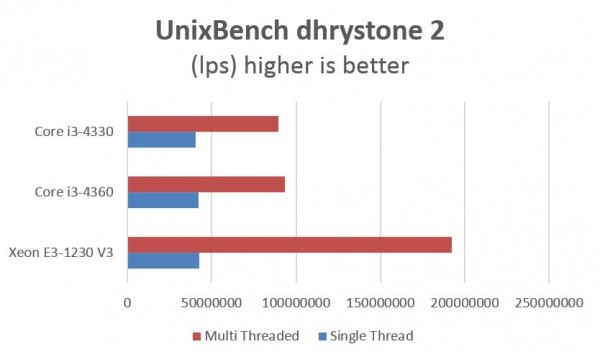
UnixBench performance illustrates the single and multi-threaded integer performance differences. Clock-for-clock the Haswell micro architecture at similar speeds will perform about the same. Adding cores is how Intel is getting more performance.
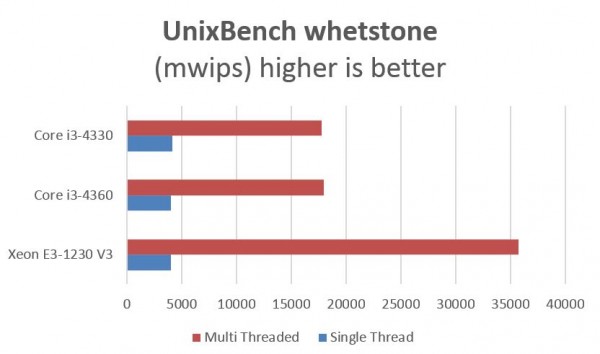
We see the same thing on the floating point performance. These days, most applications are multi-threaded and servers with this much power can run multiple virtualized applications without major issues.
Conclusion
From a power consumption perspective, these platforms are very similar with only single digit watts difference in most scenarios, with a maximum of around 22w and 1-2w at idle difference. There is a big jump moving down to the Atom C2000 series or up to the Xeon E5 series but on the LGA1155 platform there are very similar power consumption results for what most of these chips are used for. Cost wise, $120 difference is likely around 10-20% of the cost of the total platform. On the other hand, from the Core i3-4330 to the Core i3-4360 the cost difference is only a few dollars and a slight performance bump. The key takeaway here is that if one saves 10-20% on the initial purchase price of the entire system by using a Core i3 one can get about half the CPU performance. For applications like NAS systems, saving that money may make sense. For virtualized servers, the Intel Xeon E3-1200 V3 series is going to be worth the premium.

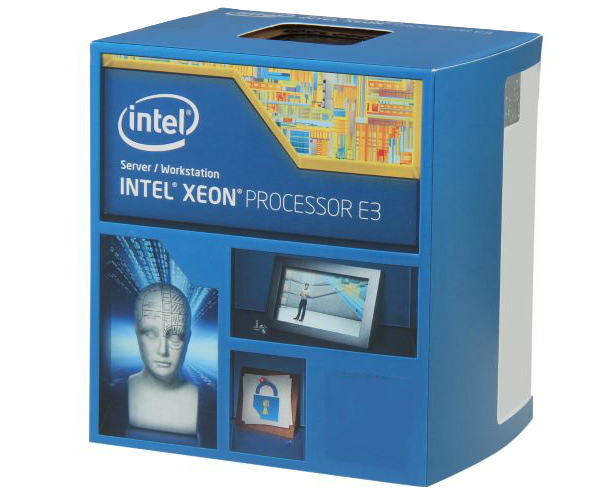



I bought myself yesterday a second hand e3 1230 + sm x9scmf, got a nice deal but I could maybe upgrade my celeron g860s to fitting i3s.
What about ECC memory support on the I3’s? is that supported?
Shouldn’t this be compared to a i7-4770 or likewise.
In my view it is not fair to compare it to a i3 or i5.